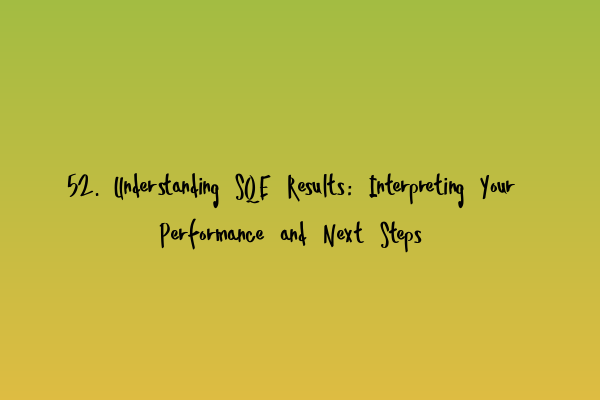Understanding SQE Results: Interpreting Your Performance and Next Steps
So, you’ve taken the Solicitors Qualifying Examination (SQE) and received your results. Congratulations on making it this far! But now, you may find yourself wondering, what does it all mean? How can you interpret your performance, and what should be your next steps on the path to becoming a qualified solicitor? In this blog post, we’ll dive deep into understanding SQE results and provide insights on what you can do to continue your journey towards success.
Before we proceed, if you haven’t already, we highly recommend checking out our related articles for a more comprehensive understanding of the SQE exams and how to prepare:
– SQE 1 Practice Exam Questions
– SQE 1 Practice Mocks FLK1 FLK2
– SQE 2 Preparation Courses
– SQE 1 Preparation Courses
– SRA SQE Exam Dates
Now, let’s delve into understanding how to interpret your SQE results.
1. Understanding the Grading Scheme:
The SQE utilizes a grading scale of Competent (C) and Not Competent (NC) as opposed to the traditional percentages or letter grades. It’s important to note that the SQE is a competency-based assessment that focuses on practical skills and applying legal knowledge in real-life situations.
2. Analyzing Your Performance:
Upon receiving your SQE results, carefully review and analyze each exam component to identify areas where you excelled and areas that may require further improvement. This analysis will help you gauge your strengths and weaknesses and guide your future study plan.
3. Seeking Feedback:
If you’re unsure about certain aspects of your performance or would like additional insights, consider reaching out to your tutors, mentors, or study groups for feedback. Sometimes an external perspective can shed light on areas of improvement that you may have missed. Don’t hesitate to ask for assistance and guidance when necessary.
4. Identifying Knowledge Gaps:
One of the key benefits of analyzing your SQE results is identifying any knowledge gaps. Pinpointing these areas will enable you to focus your efforts on acquiring the necessary knowledge and skills to excel in future attempts or the next stage of the qualification process.
5. Creating a Study Plan:
Armed with the knowledge of your strengths and weaknesses, it’s time to create a targeted study plan. This plan should address the identified knowledge gaps and address areas where you need improvement. Utilize resources such as practice exams, study guides, and online courses to enhance your understanding and competence.
6. Implementing Effective Study Strategies:
While studying for the SQE, it’s crucial to adopt effective study strategies that work best for you. Experiment with different techniques, such as active learning, spaced repetition, and practice-based learning, to optimize your retention and understanding of the material.
7. Exam Day Preparation:
As you progress on your SQE journey, it’s important to be well-prepared for exam day. Familiarize yourself with the exam format, timing, and any specific requirements. Don’t forget to utilize the practice resources mentioned in our related articles to build your confidence and enhance your exam performance.
8. Seeking Professional Support:
If you find yourself struggling or needing additional guidance, don’t hesitate to seek professional support. Consider enrolling in SQE preparation courses to receive expert tuition and access to comprehensive resources that will help you navigate the exam process successfully. Our related articles provide information on both SQE 1 and SQE 2 preparation courses to assist you in making informed decisions.
Remember, the SQE is not an easy feat, but with determination, hard work, and a well-thought-out plan, you can overcome any hurdles along the way. Embrace your results as a stepping stone towards your ultimate goal of becoming a qualified solicitor, and use them as motivation to strive for continuous improvement.
We hope this blog post has provided you with valuable insights into interpreting your SQE results and the next steps to take in your journey. Don’t forget to explore our related articles for more in-depth information and resources.
If you have any questions or would like further guidance, feel free to reach out to us. We’re here to support you every step of the way.
Good luck and keep pushing forward!
